
- •Preface
- •Content
- •Tissues
- •Nerve Tissue
- •Skin - Epidermis
- •Skin - Dermis
- •Skin - Glands
- •Subcutaneous Layer
- •Skeleton
- •Axial Skeleton
- •Cranium
- •Cranial Bones – Inferior Nasal Concha
- •Vertebral Column
- •Sacrum and Coccyx
- •Ribs
- •Sternum
- •Clavicle
- •Scapula
- •Humerus
- •Ulna
- •Radius
- •Metacarpals and Phalanges
- •Pelvis - Male
- •Femur
- •Tibia
- •Fibula
- •Tarsal Bones - Cuboid and Navicular
- •Phalanges
- •Patella
- •Skeletal Muscles
- •Transversospinales Muscles
- •Cervical Hypaxial Muscles
- •Thoracic and Abdominal Hypaxial Muscles
- •Shoulder Muscles - Rotator Cuff
- •Shoulder Muscles - Prime Movers
- •Anterior Brachial Muscles
- •Posterior Brachial Muscles
- •Posterior Thigh Muscles
- •Thigh Muscles
- •Lateral Leg Muscles
- •Posterior Leg Muscles
- •Spinal Nerves
- •Dorsal Rami
- •Intercostal Nerves
- •Cutaneous Nerves
- •Autonomic Nerves
- •Spinal Cord
- •Brain
- •Cerebrum
- •Cerebellum
- •Meninges
- •Hypothalamus
- •Pituitary Gland
- •Pineal Gland
- •Thymus
- •Pancreas
- •Ovaries
- •Testes
- •Blood
- •Heart
- •Lymphatics
- •Larynx
- •Lungs
- •Cast of Trachea and Bronchial Tree
- •Esophagus
- •Stomach
- •Pancreas
- •Large Intestine
- •Mesenteries
- •Omenta
- •Female Reproductive Organs
- •Ovary
- •Vagina
- •Ductus Deferens and Spermatic Cord
- •Penis
- •Index
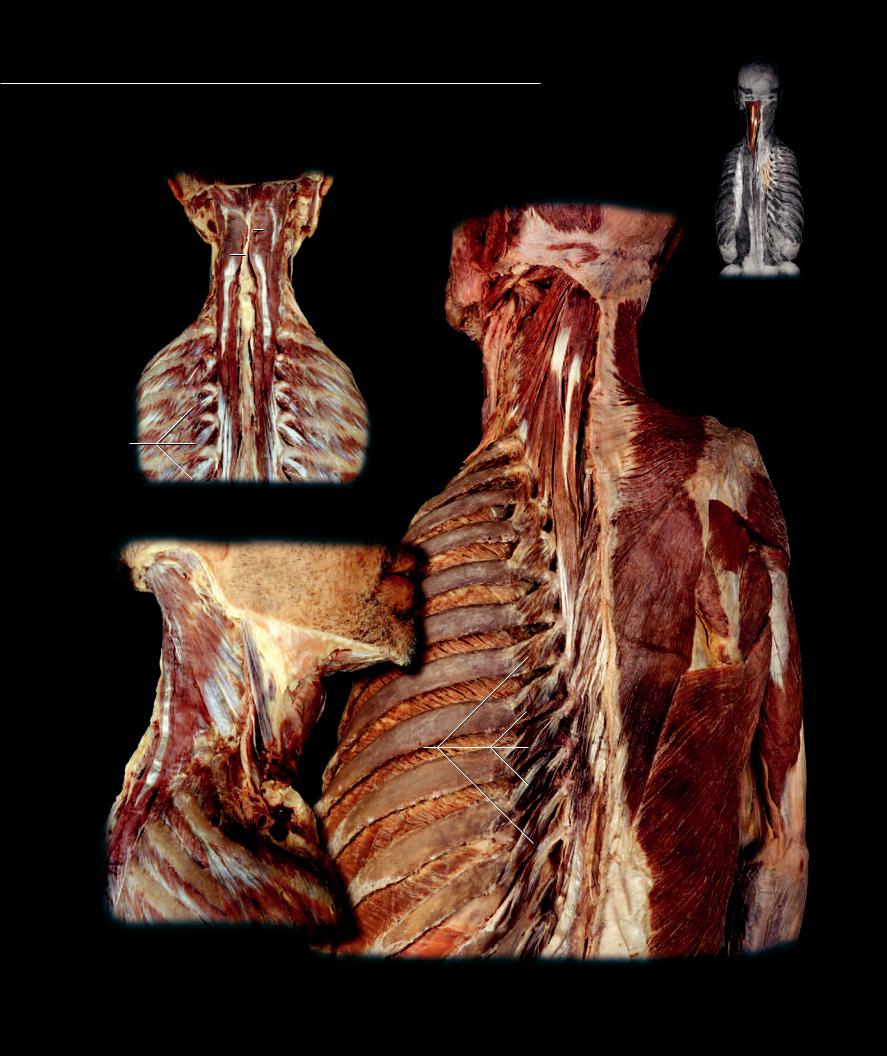
Transversospinales Muscles The transversospinales
muscles form the third layer of epaxial muscles. This deeper layer of muscles has shorter muscle fibers, on average, than its two superficial counterparts, and the fibers angle from lateral (transverse processes) to medial (spinous processes) as they course from sacrum to cranium. Within this group there are three muscles — the semispinalis, multifidus, and the rotatores muscles. The more superficial semispinalis muscle is depicted on this page.
12 9
18
12
|
15 |
14 |
19 |
Dissection of semispinalis muscles |
24 |
|
Posterior view |
||
|
||
|
22 |
|
|
23 |
|
|
20 |
|
|
10 |
|
12 |
|
25
14
21
16
15
13
Dissection of semispinalis muscles
Lateral view
Dissection of semispinalis layer on left and limb muscles on right
Posterolateral view
161
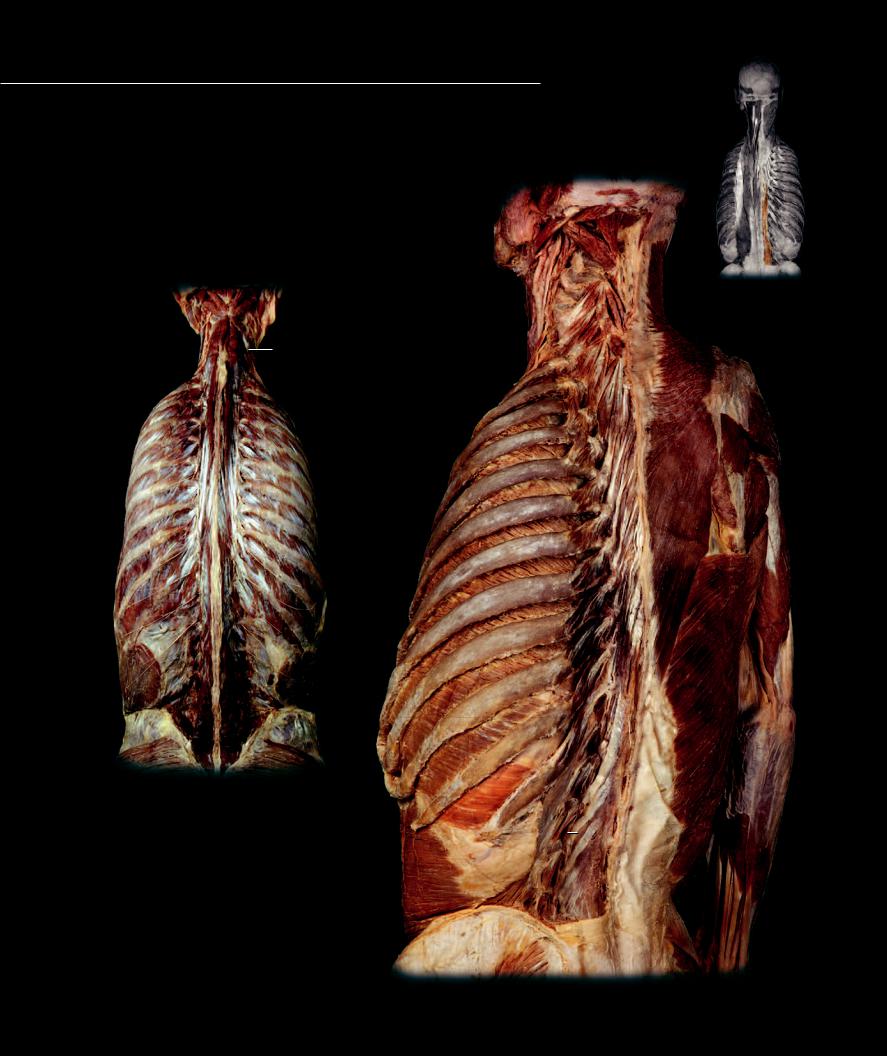
The multifidus layer of the transversospinales musculature is highlighted on
this page, and the deeper rotatores are evident on the opposite page along with the deeper intersegmental muscles. The multifidus muscles span three to fi ve vertebral levels in their span from the sacrum to the second cervical vertebra, while the deepest member, the rotatores, typically span only one to two vertebrae. The transversospinales muscles assist their more superficial counterparts with extension of the vertebral column and play important roles in the maintenance of posture.
6 5
27 4
7 13
11
3
11 19
|
20 |
|
|
|
21 |
|
23 |
|
2 |
25 |
24 |
|
17 |
10 |
26
22
14
1
18
Dissection of multifidus muscles
Posterior view
12
1
15
16
Dissection of multifidus and intersegmental muscles
162 |
Posterolateral view |
|
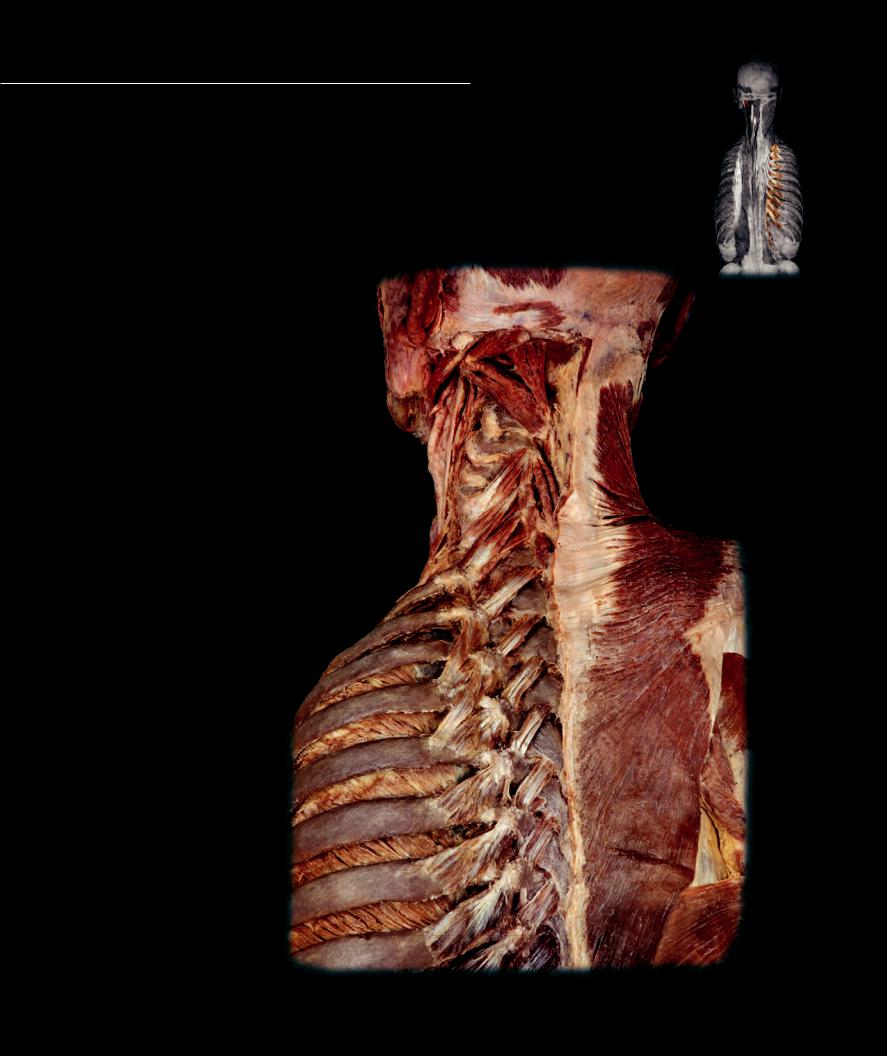
The small intersegmental muscles — the interspinales muscles, intertransversarii muscles, levatores costarum,
and subocciptal muscles — in general span a single intervertebral joint. The interspinales and intertransversarii muscles contribute little to any significant vertebral movements. They contain large numbers of sensory neurons within their muscultendinous fasciculi. These spindle-like sensory receptors in the muscles monitor muscle tension. These small muscles, with their poor mechanical advantage, probably function as receptors that monitor the regional movements of the vertebral column and supply feedback that infl uences the action of the larger surrounding muscles. Associated deep in the junction of the cranium and vertebral column are the four suboccipital muscles. The suboccipital muscles are homologous to the other deep muscles at more inferior vertebral levels, but are developmentally modified and enlarged to function with their specialized vertebral counterparts — the axis, atlas, and occipital bone.
|
|
28 |
|
|
|
|
29 |
Multifidus, Rotatores, and Intersegemental Muscles |
|
6 |
|
1 |
Multifidus lumborum muscle |
|
|
2 |
Multifidus thoracis muscle |
|
5 |
|
4 |
||
3 |
Multifidus cervicis muscle |
27 |
|
4 |
Rectus capitis posterior major muscle |
|
7 |
5 |
Rectus capitis posterior minor muscle |
|
|
|
13 |
||
6 |
Obliquus capitis superior muscle |
|
|
|
|
||
7 |
Obliquus capitis inferior muscle |
|
|
8 |
Rotatores cervicis muscle |
|
|
9 |
Rotatores thoracis muscle |
|
|
10 |
Levatores costarum muscle |
|
|
Other Muscles and Structures |
|
11 |
|
|
|
||
11Semispinalis cervicic muscle
12Medial lumbar intertransversarii muscle
13 |
Nuchal ligament |
3 |
8 |
14 |
External oblique muscle |
|
|
|
|
||
15 |
Transversus abdominis muscle |
|
|
16 |
Quadratus lumborum muscle |
|
9 |
17External intercostal muscle
18Internal intercostal muscle
19Middle scalene muscle
20 |
Trapezius muscle |
9 |
|
21 |
Deltoid muscle |
10 |
|
22 |
Latissimus dorsi muscle |
||
23 |
Infraspinatus muscle |
9 |
|
24 |
Teres major muscle |
|
|
25 |
Rhomboideus major muscle |
10 |
|
26 |
Triceps muscle |
||
9 |
|||
27 |
Posterior digastricus msucle |
||
|
|||
28 |
Auricularis posterior muscle |
10 |
|
29 |
Transversus nuchae muscle |
|
|
|
|
9 |
|
|
|
10 |
|
|
|
9 |
|
|
18 |
10 |
|
|
|
9 |
|
|
|
10 |
Dissection of upper deep intersegmental muscles on left
Posterior view |
163 |
|
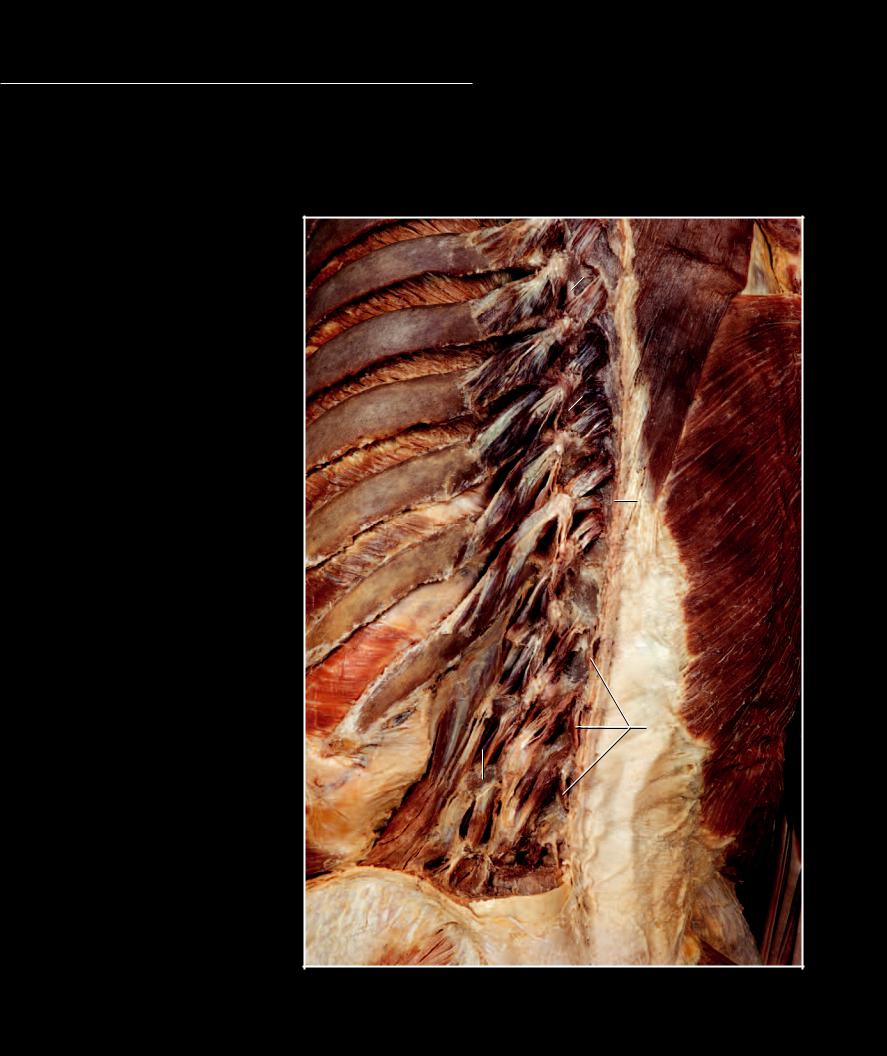
The intertransversarii muscles are a mixed group that are technically misnamed. The epaxial intertransverse muscles (present at cervical, thoracic, and lumbar
levels) are the “true intertransverse” muscles. They attach to the transverse elements of the vertebral arch. The hypaxial intertransverse muscles should be named intercostal muscles. They are only present in the cervical and lumbar regions and attach to the costal processes (ribs) of the cervical and lumbar vertebrae, which are unfortunately named transverse processes even though they are not homologous with the thoracic transverse processes. These cervical and lumbar transverse processes are homologous with the thoracic ribs. There are no thoracic hypaxial intertransverse muscles because they are already present as the intercostal muscles and in this region they are properly named.
Rotatores and Intersegemental Muscles 1 Rotatores thoracis muscle
2 Rotatores lumborum muscle
3 Levatores costarum muscle
4 Interspinales thoracis muscle
5 Interspinales lumborum muscle
6 Thoracic intertransversarii muscle
7 Medial lumbar intertransversarii muscle
Other Muscles and Structures
8Intertransversarii laterales lumborum muscle - dorsal part
9Intertransversarii laterales lumborum muscle - ventral part
10Internal intercostal muscle
11Quadratus lumborum muscle
12Iliocostalis muscle (cut)
13Multifidus muscle (cut)
14Trapezius muscle
15Latissimus dorsi muscle
16Rib 12
17Iliac crest
18Thoracolumbar fascia
19Supraspinous ligament
1
14
6
1
3
1
3
6
31
1
10
3 |
4 |
15
1
3
10
19
16 |
9 |
2 |
|
7 |
|||
8 |
|||
|
|
18
72
5
8
11
9 2
7
9 
8
17 |
12 |
13 |
|
|
Dissection of lower deep intersegmental muscles on left
Posterolateral view
164

The hypaxial muscles develop from the hypomere of each somite’s myotome and form the lateral and ventral muscle wall of the trunk. As the hypomeres migrate to form the ventrolateral muscle wall of the
trunk, a repeating segmental pattern emerges. This common muscle pattern is present in the anterior and lateral muscles of the neck, the thorax, the abdomen, and in a modifi ed form in the wall and fl oor of the pelvis. Each hypomere contributes six basic muscles, per side, to the trunk wall. The six muscles are a ventral muscle, a series of four superfi cial to deep lateral muscles, and a subvertebral muscle. This simple, eloquent design runs the entire length of the trunk. Understanding and recognizing this pattern of design not only clarifies trunk wall anatomy, but also helps simplify the task of learning the myriad of hypaxial trunk muscles. These hypaxial trunk muscles are the flexors and rotators of the vertebral column. They also support the internal viscera of the abdomen and thorax and play important roles in respiration, vocalization, urination, and defecation. The ventral (anterior) ramus of each spinal nerve supplies all of the hypaxial muscles. The hypaxial muscle pattern and the muscles that form the pattern are summarized below. On the next two pages the pattern is clearly demonstrated.
Hypaxial Muscle Pattern
Ventral musculature
Four-layered lateral musculature
Supracostal or outermost muscle layer |
|
External muscle layer |
|
Middle muscle layer |
|
Internal muscle layer |
|
Subvertebral musculature |
|
Cervical Hypaxial Muscles |
Lumbar Hypaxial Muscles |
Ventral musculature |
Ventral musculature |
Geniohyoid muscle |
Rectus abdominis muscle |
Thyrohyoid muscle |
Pyramidalis muscle |
Superior omohyoid muscle |
Four-layered lateral musculature |
Inferior omohyoid muscle |
Supracostal layer |
Sternothyroid muscle |
External oblique muscle - superficial lamina |
Sternohyoid muscle |
External layer |
Four-layered lateral musculature |
External oblique muscle - deep lamina |
Supracostal layer |
Middle layer |
Levator scapulae muscle |
Internal oblique muscle |
External layer |
Cremaster muscle |
Posterior scalene muscle |
Intertransversarii laterales lumborum muscle - dorsal part |
Middle layer |
Internal layer |
Middle scalene muscle |
Transversus abdominis muscle |
Lateral posterior cervical intertransversarii muscle |
Quadratus lumborum muscle |
Internal layer |
Intertransversarii laterales lumborum muscle - ventral part |
Anterior scalene muscle |
Subvertebral musculature |
Anterior cervical intertransversarii muscle |
Psoas major muscle (annexed by the limb) |
Subvertebral musculature |
Psoas minor muscle |
Longus capitis muscle |
|
Longus colli muscle |
Pelvis/Perineal Hypaxial Muscles |
|
Ventral musculature |
Thoracic Hypaxial Muscles |
Not present as it terminates on the pubic crest |
Ventral musculature |
Four-layered lateral musculature |
Sternalis muscle (present in about 10% of people) |
Supracostal layer |
Four-layered lateral musculature |
Not present |
Supracostal layer |
External layer |
Serratus posterior superior muscle |
Obturator externus muscle (annexed by the limb) |
Serratus posterior inferior muscle |
Bulbospongiosus muscle |
Rhomboideus major muscle (annexed by the limb) |
Ischiocavernosus muscle |
Rhomboideus minor muscle (annexed by the limb) |
Superficial transverse perinei muscle |
Serratus anterior muscle (annexed by the limb) |
Superficial external anal sphincter |
External layer |
Middle layer |
External intercostal muscle |
Obturator internus muscle (annexed by the limb) |
Middle layer |
Deep transverse perinei - male |
Internal intercostal muscle |
Compressor urethrae - female |
Internal layer |
Sphincter urethrovaginalis -female |
Innermost intercostal muscle |
External urethral sphincter |
Subcostal muscle |
Deep external anal sphincter |
Transversus thoracis muscle |
Internal layer |
Diaphragm |
Levator ani muscle |
Subvertebral musculature |
Ischiococcygeus muscle |
Longus capitis muscle |
Subvertebral musculature |
|
Not present as psoas is annexed by the limb |
165

The dissection photos on this and the facing page clearly depict the pattern of design that arises from the hypomere migration in the trunk wall. Note that
both the ventral and subvertebral muscles are reduced in the thorax because the sturdy thoracic cage leads to a lack of mobility in the thoracic vertebral column. Also, note that the lateral supracostal muscles of the neck and thorax are annexed by the pectoral girdle to support the unattached upper limb. The clear relationship of the serratus anterior and its abdominal homologue – the superfi cial lamina of the external oblique muscle – is also evident, as well as the continuity of the deep lamina of the external oblique and its homologue, the external intercostal muscle. Finally, note how the subvertebral psoas major is annexed away from the sacrum and onto the lower limb.
3 |
|
6 |
|
||
|
|
|
|
|
4 |
|
|
1 |
|
2 |
10 |
7
11
8
5
9
12
Ventral hypaxial muscles |
Lateral supracostal hypaxial muscles |
Lateral external hypaxial muscles |
Anterior view |
Lateral view |
Lateral view |
166
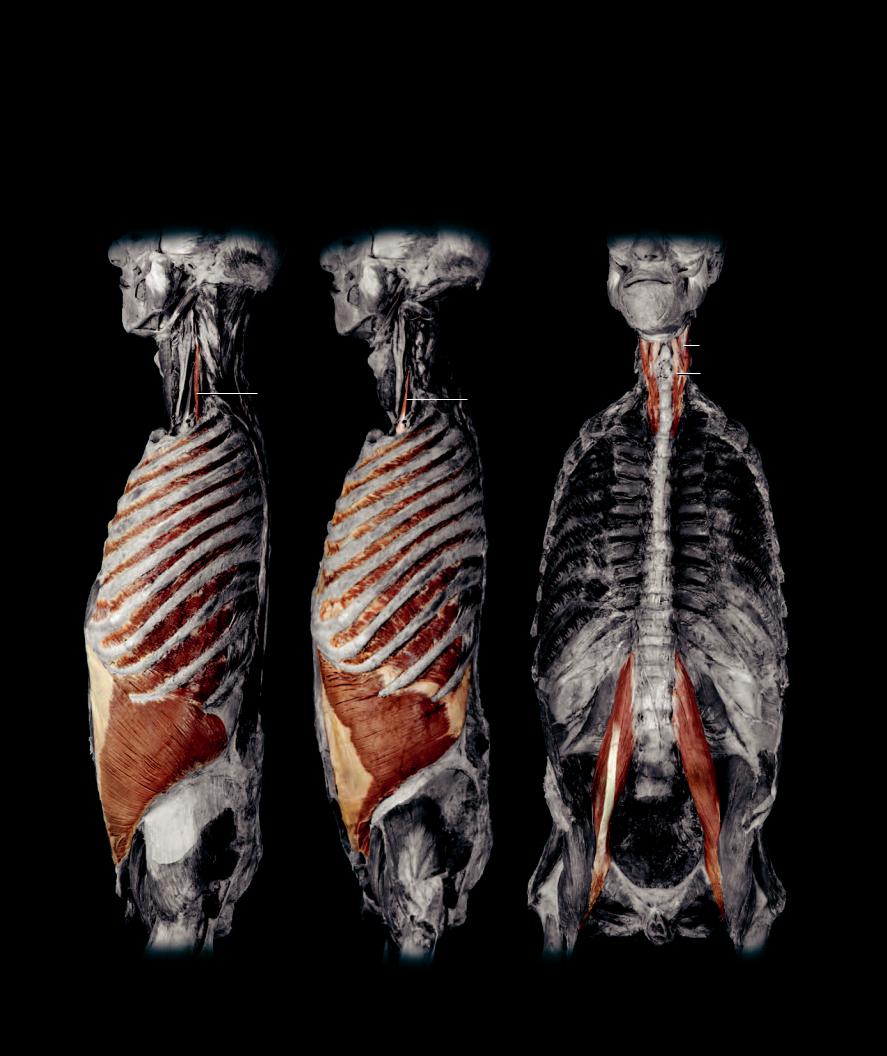
Ventral Musculature |
Lateral External Musculature |
||
1 |
Sternohyoid muscle |
10 |
Posterior scalene muscle |
2 |
Sternothyroid muscle |
11 |
External intercostal muscle |
3 |
Thyrohyoid muscle |
12 |
External oblique muscle (deep lamina) |
4 |
Omohyoid muscle |
|
|
5 |
Rectus abdominis muscle |
Lateral Middle Musculature |
|
|
|
13 |
Middle scalene muscle |
Lateral Supracostal Musculature |
14 |
Internal intercostal muscle |
|
6 |
Levator scapulae muscle |
15 |
Internal oblique muscle |
7 |
Serratus anterior muscle |
|
|
8 |
Serratus posterior inferior muscle |
Lateral Internal Musculature |
|
9 |
External oblique muscle (superficial lamina) |
16 |
Anterior scalene muscle |
17Innermost intercostal muscle
18Transversus abdominis muscle
Subvertebral Musculature
19Longus capitis muscle
20Longus colli muscle
21Psoas major muscle
22Psoas minor muscle
19
20
13 |
16 |
|
14 |
17 |
22
18
15
21
Lateral middle hypaxial muscles |
Lateral internal hypaxial muscles |
Subvertebral hypaxial muscles |
Lateral view |
Lateral view |
Lateral view |
167
